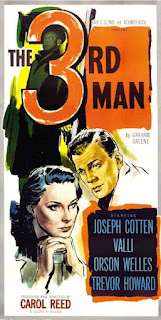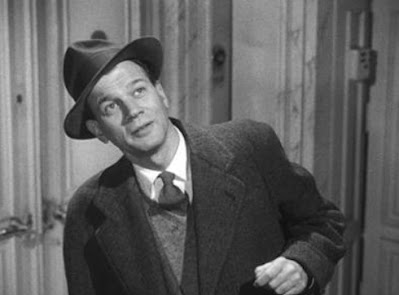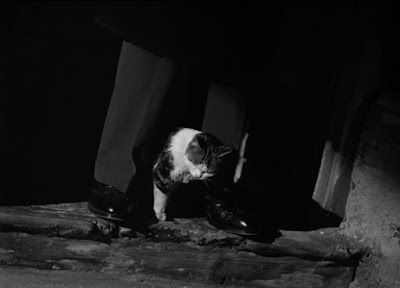Directed by: Carol Reed
Music: Anton Karas
Starring: Joseph Cotton, Alida Valli,
Orson Welles, Trevor Howard,
Paul Hörbiger, Siegried Breuer,
Wilfred Hyde-White
I love film noir. I also love suspense films (these terms are not interchangeable, even though they are often used as synonyms). So when my husband, browsing The Criterion Channel, decided to watch The Third Man, I settled down to watch.
Vienna, shattered by the Second World War, is divided into four zones – American, British, French and Soviet; the centre of the town is an international zone, governed by the International Military. This is where Holly Martins (Joseph Cotton), a writer of pulp westerns, lands up, at the invitation of an old friend Harry Lime (Orson Welles).
Unfortunately for
him, Lime was killed just that morning; a hit-and-run while crossing the street
in front of his apartment, Martins is told. At Lime's funeral, Martins meets
Major Calloway (Trevor Howard) and Sergeant Paine (Bernard Lee) of the British
Royal Military Police. The latter turns out to be a huge fan of Martin’s books,
but Major Calloway encourages Martins to leave Vienna. Lime was a bad man, he
says, and it is better that Martins doesn’t hang around. He orders his sergeant to ensure that Martins does as he's told.
Fortunately for Martins, he runs into a Mr Crabbin (Wilfred Hyde-White), who upon learning that Martins is an author, invites him to address the book club that he runs. They would put Martins up until then, he says. At the hotel, Martins is also met by a Baron Kurtz (Ernst Deutsch) who introduces himself as a friend of Harry Lime. He informs Martins that it was while crossing the road to greet him and a mutual friend Popescu (Siegfried Breuer) that Lime was run over. They had carried him to the footpath, where Lime had told him about Martins’ impending arrival, and begged Kurtz to take care of him.
Martins had glimpsed a woman at Lime's funeral. She’s Anna Schmidt (Alida Valli), Lime's girlfriend, a theatre artiste. Anna is devastated by Lime's death, but her account of the accident – she was told that Lime was accidentally run over by his own driver and declared dead by his personal physician – is too incredible to be believed. How did the doctor happen to be there just then? Martins begins to suspect that Limes’ death was no accident.
This suspicion is cemented when Martins speaks to the porter, Karl (Paul Hörbiger), at Lime's apartment building. Initially reluctant to talk, Karl tells him that Lime had died immediately and that, three men, not two, had carried him off the road. But he refuses to be involved further.
Martins, now very suspicious indeed, decides to pay a visit to Dr Winkel (Erich Ponto). The doctor tells him that when he arrived at the scene, there were only two men present. The porter must be mistaken. Meanwhile, Anna’s flat is being searched by the British police and her passport confiscated. Upon closer scrutiny, it is discovered to be forged. Anna is cautioned, but allowed to return home pending investigation.
Karl, too, is having second thoughts – he sends word to Martins asking him to come to the flat in the evening. Only, when Martins reaches there, it is to find the man dead. Accused of the murder, Martins manages to flee the hostile crowd, by slipping into book club where he’s due to lead a discussion.
Totally flustered by now and unprepared for the occasion, Martins loses track of his speech. When the floor is opened to questions, Martins notices Popescu, who asks him what his next book is about.
Defiantly, Martins remarks that it is a murder mystery based on facts – to be named The Third Man. Popescu quips that perhaps it would be safer for Martins to stick to fiction. Noticing two thugs walking towards him from behind Popescu, Martins flees the room.
He approaches Calloway, who advises Martins to leave Vienna. Martins refuses – he isn’t going anywhere until his friend’s murderer is brought to book. Calloway is forced to inform Martins that Lime wasn’t who he thought he was – he was a racketeer who stole penicillin from military hospitals and sold a diluted form in the black market. Calloway shows Martins the immeasurable harm that diluted penicillin caused Lime's victims, including little children. The lucky ones, says Calloway...
Martins is shocked
and agrees to leave. That evening, Martins visits Anna, who tells him that Calloway
had informed her of Limes’ crimes too. As they talk, the Soviet police come to
arrest Anna and to deport her. Martins hides.
When Martins leaves
Anna’s apartment, he notices someone hiding in the shadows.
As the light from an open window throws the recess into relief, Martins sees… the third man.
Written by Graham Greene as a novella so he could delineate the characters, plot and setting before writing the screenplay, The Third Man was filmed mostly on location in Vienna. Under Carol Reed's direction, the war-torn city comes alive as a character of its own in the film. The climax scene in the city’s sewers, unfortunately, was shot in the studio, given the lead’s reluctance to shoot on location.
Both Reed and Greene knew the devastation of war first-hand. Reed had worked with the British Army’s documentary unit and Greene had been inducted into MI6. The latter had translated many of his experiences into his writings about espionage, and used it here, as well. However, Reed also ensured that his trademark dark humour was infused into the script, in the form of dialogue and one-liners.
The musical score complemented the mood of the film – Reed had met Anton Karas at welcome party in Vienna and was so beguiled by the tune he was playing on his zither that he invited him to turn that into the theme music for the film. Karas’s zither adds an almost joyful note to the scenes, adding to the mixture of humour and underlying tension on screen. Additional music was composed by Hubert Clifford under his pseudonym Michael Sarsfield.
The Third Man is deservedly known for its cinematography. Robert Krasker shot Vienna with its broken-down buildings, mounds of rubble and gaping craters a stark reminder of the devastation unleashed by war. The light and shadows created by the harsh lighting build up the suspense – there is a nightmarish quality to the chase sequence in the climax that owes as much to the lighting and camera work as it does to the actors participating in the scene.
Even otherwise, the angles were interesting, to say the least, winning for Krasker an Academy Award for Best Cinematographer.
The ending is very satisfying, though I went through a couple of WTH moments – if it had been left to Greene, I may have torn my hair out in despair, but Reed fought with both Greene and Selznick (David. O., the producer) to retain the ending he wanted.
Selznick, in fact, insisted upon an 'American cut', which gave the narrative voiceover to Holly Martins instead of the anonymous racketeer voiced by Reed himself, and enlarged upon the 'average American hero' theme that was popular in Hollywood at the time. He also 're-cut' several of Reed's scenes, interfering not only with Reed's directorial vision, but the logical continuity of the film. Thankfully, Reed prevailed in his arguments, and with the justified anonymity of Selznick's 'cut' (and Orson Welles's looming shadow over the film) The Third Man deservedly takes its place among the British Film Institute’s Top 100 British Films.













No comments:
Post a Comment